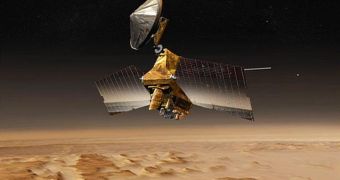Officials with the NASA Jet Propulsion Laboratory (JPL) in Pasadena, California announce that the Mars Reconnaissance Orbiter (MRO) has just turned 5. The spacecraft achieved orbital insertion around the Red Planet on March 10, 2006.
According to scientists, this particular vehicle is one of the most versatile and well-built orbiter ever to be sent in space. It carries a complete suite of scientific instruments, that can be used in a variety of combinations to capture data scientists are interested in.
In the time it spent orbiting our neighboring planet, the probe has contributed to expanding our understanding of Mars, its atmosphere and geology, and also its geography and topology.
It provided JPL mission controllers with extensive datasets on the ancient environments that may have existed on the Red Planet millions to billions of years ago, as well as on the ice-age-scale climate cycles and present-day changes taking place right now.
Over the past 5 years, the MRO has sent back more than 70,000 images, which is more than all other planetary missions NASA ever sent combined. The data transfer counter for its high-gain communication antenna now stands at 131 terabits.
At first, the space probe was supposed to remain in Martian orbit for only 2 years. By 2008, it had already completed all of its primary science mission objectives, and so NASA decided to give the mission two extensions, 2008-2010 and 2010-onwards.
A critical aspect of MRO's success is the fact that it's capable of carrying out tasks that have nothing to do with scientific exploration, such as for example acting as a relay post for communications coming from the planet's surface.
Both of the twin NASA rovers Spirit and Opportunity are equipped with both low- and high-gain antennas, but they only use the former to contact the MRO. The JPL team – which manages both missions – realized that they had no reason to use high-gain antennas to contact Earth directly.
The rovers transmitted their data to the MRO via the low-gain antenna, and the orbiter then passed them on. The spacecraft has sufficient power to communicate with Earth, whereas dust is limiting the ability of solar panels on the rovers to produce electricity.
JPL experts say that the MRO was also used to establish contact with the Phoenix Mars Lander, which arrived on the Red Planet at the end of 200 for a 4-month mission. The orbiter was also capable of collaborating with the Mars Odyssey spacecraft in establishing these relay patterns.
“Each Mars year is unique, and additional coverage gives us a better chance to understand the nature of changes in the atmosphere and on the surface,” says JPL MRO project scientist Rich Zurek.
“We have already learned that Mars is a more dynamic and diverse planet than what we knew five years ago. We continue to see new things,” he goes on to say.

 14 DAY TRIAL //
14 DAY TRIAL //